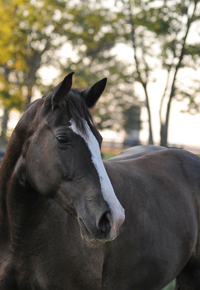As we begin a show season, it’s easy to mistake Human enthusiasm for preparedness. Unless you were able to keep training through the winter with an indoor arena (you poor thing), Humans are likely at their flabbiest in April, and this also means their connective tissues are at their least flexible. It’s a good bet they haven’t improved the situation much by now.
I like to get a baseline for the Biped’s flexibility and athleticism by turning a lumber in from the field into a sudden leaping dance. Her reaction time, combined with the volume of her yelp, tell me whether her arms are limber or stiff.
But proper stretching shouldn’t be neglected in warmer weather either. Limbered Humans are more likely to put in better performance. And (possibly) squeal less. It also stimulates blood flow and nerve health, which can only help as she struggles mightily to sit the trot.
ADVERTISEMENT
There are lots of ways to limber the Human, and I advise testing various methods to see what fits best with your training schedule. Be aware that stretching the Human too much will not only produce screaming but will make it difficult for her to carry feed pails and reach into the peppermint drawer for a couple of days. Don’t ask me how I know this.
- The Mud Stretch: Grooming has many benefits for Humans, including overall improved circulation, but creative mud application can help stretch out those arms. I like to accumulate stubborn little beads of mud fused to the long hairs on the insides of my hind legs.This requires the Biped to hit the ground, twist around, and stretch up in order to clean properly without risking a kick. The nice thing about little beads of mud like this is they’re never really all gone. One good stomp in a puddle, and you’ll have material for days.
- The Bicep Brace: Once the Human is mounted, I like to pick one corner of my mouth to clench, requiring a tensed bicep to maintain a stable contact. (Or, if she can’t tighten her bicep, she simply tips gradually forward until she flops onto my neck. This is also fine.)She she will almost certainly be too weak to maintain a stable contact throughout the ride, her arms will naturally wander forward and be tucked back (when she remembers that they are there), creating a slow, burning sort of stretch. Don’t forget to alternate sides to work both arms.
- The Big Gulp: I’m already a fan of taking in a big breath while the Biped huffs and puffs her way through tightening the girth. For one thing, I think it’s unfair that my belt should be both shorter than hers and worn tighter, and for another, I like to engage in thoughtful, breathing meditation before a training session.One of the ancillary benefits of this practice is the Human will realize (after the saddle flips upside down and she falls on her face once or twice) that the girth must be tightened in stages. This means she’ll stretch out various muscles in her arms (and if she is really out-of-shape, her groin) three to four times before mounting. Try to avoid laughing at the grunting noises she will make.
- The Runner’s Lunge: As we “enjoy” summer in central Kentucky, the pipsqueak has decided I need to wear a fly mask during the day. On days when I leave the mask in the field (WHERE IT BELONGS), I like to extend the ride as long as possible, so she has to march around the fenceline, desperately looking for the mask before the sun finishes going down.I wish I could say I require her to run while she does this, but I’m often munching on hay by the time she goes out. A brisk walk is still better than a(nother) gossip sesh on the tack trunk.
- The Hay Bale Hoist: Don’t neglect the Human’s core muscles! It is these that keep her from flailing all over the place on cross-country. I’ve found lifting and carrying hay bales to be good exercise for the Human’s abs (which I assume are under there somewhere, beneath the weekend’s fried chicken and ice cream).
I make sure she has to fetch more hay frequently by diplomatically convincing passersby that I am starving and have not eaten hay in weeks. My performances, which are Oscar-worthy, often result in increasingly frequent trips to the hay loft in the upper barn to pick up more bales.The hay rash she develops doing this are an unfortunate (and unsightly) side effect. Do be careful not to overdevelop these however, as a rider with a six-pack can insist upon more consistent dressage frames.
 |
Jitterbug is a Michigan-bred Professional Draft Cross who skillfully avoided saddles until age 5. Since then, she has been lauded for her talent in successfully managing humans while training herself to one day achieve eventing greatness. Jitter and her human live in central Kentucky. Read all of Jitter’s COTH columns. Follow Jitterbug on Facebook! Photo by Dark Horse Photography. |














